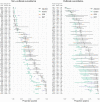Estimating the proportion of clinically suspected cholera cases that are true Vibrio cholerae infections: A systematic review and meta-analysis
- PMID: 37708235
- PMCID: PMC10538743
- DOI: 10.1371/journal.pmed.1004286
Estimating the proportion of clinically suspected cholera cases that are true Vibrio cholerae infections: A systematic review and meta-analysis
Erratum in
-
Correction: Estimating the proportion of clinically suspected cholera cases that are true Vibrio cholerae infections: A systematic review and meta-analysis.PLoS Med. 2025 Sep 11;22(9):e1004743. doi: 10.1371/journal.pmed.1004743. eCollection 2025 Sep. PLoS Med. 2025. PMID: 40934163 Free PMC article.
Abstract
Background: Cholera surveillance relies on clinical diagnosis of acute watery diarrhea. Suspected cholera case definitions have high sensitivity but low specificity, challenging our ability to characterize cholera burden and epidemiology. Our objective was to estimate the proportion of clinically suspected cholera that are true Vibrio cholerae infections and identify factors that explain variation in positivity.
Methods and findings: We conducted a systematic review of studies that tested ≥10 suspected cholera cases for V. cholerae O1/O139 using culture, PCR, and/or a rapid diagnostic test. We searched PubMed, Embase, Scopus, and Google Scholar for studies that sampled at least one suspected case between January 1, 2000 and April 19, 2023, to reflect contemporary patterns in V. cholerae positivity. We estimated diagnostic test sensitivity and specificity using a latent class meta-analysis. We estimated V. cholerae positivity using a random-effects meta-analysis, adjusting for test performance. We included 119 studies from 30 countries. V. cholerae positivity was lower in studies with representative sampling and in studies that set minimum ages in suspected case definitions. After adjusting for test performance, on average, 52% (95% credible interval (CrI): 24%, 80%) of suspected cases represented true V. cholerae infections. After adjusting for test performance and study methodology, the odds of a suspected case having a true infection were 5.71 (odds ratio 95% CrI: 1.53, 15.43) times higher when surveillance was initiated in response to an outbreak than in non-outbreak settings. Variation across studies was high, and a limitation of our approach was that we were unable to explain all the heterogeneity with study-level attributes, including diagnostic test used, setting, and case definitions.
Conclusions: In this study, we found that burden estimates based on suspected cases alone may overestimate the incidence of medically attended cholera by 2-fold. However, accounting for cases missed by traditional clinical surveillance is key to unbiased cholera burden estimates. Given the substantial variability in positivity between settings, extrapolations from suspected to confirmed cases, which is necessary to estimate cholera incidence rates without exhaustive testing, should be based on local data.
Copyright: © 2023 Wiens et al. This is an open access article distributed under the terms of the Creative Commons Attribution License, which permits unrestricted use, distribution, and reproduction in any medium, provided the original author and source are credited.
Conflict of interest statement
JL is a paid statistical advisor for PLOS Medicine.
Figures




References
Publication types
MeSH terms
Grants and funding
LinkOut - more resources
Full Text Sources
Medical
Miscellaneous

